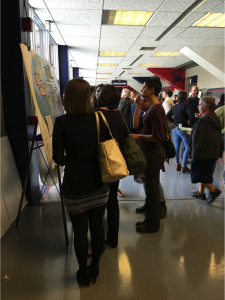VA Power Dialogue Exhibition- Shrouded Climate Disasters: War & Conflict
VA Power Dialogue: Shrouded Climate Disasters: War & Conflict
Sam Greenspan, Tia McArtis, John Murphy, Noraya Razzaque, & Natasha Shannon

Overview
Our project culminated in the creation of a poster map displaying a variety of conflicts or sites of potential conflict around the globe, all of which were influenced in one way or another by climate change. Our goals were to bring attention to the correlation between climate change and conflict throughout the world. Our display included eight sites of conflicts that have stemmed, at least in part, from climate change. Prior to the Power Dialogue, we pooled resources to research this list of conflicts, with an in-depth focus on three specific conflicts in Darfur, Syria, and Mexico. For these three, we also included personal narratives from people directly influenced by the conflict. In this way, we hoped to provide an additional personal, social perspective on the conflicts. For the other conflicts, we focused on creating brief overviews, so that our poster would express the breadth of climate-change influenced conflicts. Together, we were able to create a compelling visual representation of the global influence of climate change on human conflict. Unfortunately, when we presented the poster to the public during the VA Power Dialogue, not all of our group members could be present. Natasha and Noraya set up the map on the posterboard, tacking everything in place. Tia bore the brunt of the poster interaction, talking to people with questions about our presentation. Tia reported that many people had questions about specific details of conflicts, which were hard to address, given that our presentation was focused on breadth rather than depth. Overall, our presentation was a visual indication of the conflict aspect of climate change that begs many more questions and much more action to pursue in the future.

Click here to see a short video of Power Dialogue visitors interacting with our poster.

Abstract
Most research and media surrounding climate change has focused solely on the environmental impacts of climate change, however data has increasingly pointed to climate change as a significant factor in creating conflict around the globe. Rising temperatures, shifting precipitation patterns, sea level rise, land loss, drought, and desertification have all contributed to new paradigms in the political, economic, and social spheres of regions across the world. Since all of these spheres profoundly affect human lives, those dependent on particular environmental qualities of land for their livelihood often find themselves migrating or embroiled in bitter contests for dwindling land. This is particularly true in Africa and Latin America, where one researcher says “most places [negatively] affected by climate change are also susceptible to violent civil conflict” (Powell, 2013). Sadly, these are patterns repeated across the globe, but we hope that increased awareness of climate change’s influence on conflict will prompt preventative and responsible action on both a macro, state policy level, and on an individual, humanistic level. This map aims to pinpoint and exhibit countries and regions affected by climate change in order to raise awareness and visualize the current realities of this environmental justice issue. Additionally, country specific narratives and descriptions on the map demonstrate how the issue has come to exacerbate political, economic, and social realms and then lead to conflict and war.
Sources: Powell, A. (2013, August 15). Seeds of violence in climate change. Retrieved April 04, 2016, from http://news.harvard.edu/gazette/story/2013/08/in-climate-flux-seeds-of-war/

Bibliography
Brodziak, F., García, A. L., & Chow, L. G. (2011). Climate Change Impacts on Socio-environmental Conflicts: Vulnerability in Facing Climate Change and Social Conflicts in Mexico. Partners for Democratic Change International. Retrieved April 4, 2016, from http://www.ifp-ew.eu/pdf/1111mexico.pdf
Burke, M., Miguel, E., Satyanath, S., Dykema, J., & Lobell, D. (2009). Warming increases the risk of civil war in Africa. Proceedings of the National Academy of Sciences, 106(49), 20670-20674.
Châtel, Francesca De. “The Role of Drought and Climate Change in the Syrian Uprising: Untangling the Triggers of the Revolution.” Middle Eastern Studies 50.4 (2014): 521-35. Web.
Gelber, D., & Bach, J. (Producers). (n.d.). Watch Years – Years Of Living Dangerously [Video file]. Retrieved from http://yearsoflivingdangerously.com/watch-years/
Hoffman, M., & Grigera, A. (2013, February 26). Climate Change, Migration, and Conflict in the Amazon and the Andes. Retrieved April 04, 2016, from https://www.americanprogress.org/issues/security/report/2013/02/26/54570/climate-change-migration-and-conflict-in-the-amazon-and-the-andes/
ICE. “Extreme Events and Haitian Environmental Refugees.” American University. May 2009. Web. 03 Apr. 2016.
Kelley, Colin P. “Climate Change in the Fertile Crescent and Implications of the Recent Syrian Drought.” PNAS 112.11 (2015): n. pag. Web. 3 Apr. 2016.
Kristof, N. (2008, August 30). Tortured, but Not Silenced. New York Times. Retrieved April 5, 2016, from http://www.nytimes.com/2008/08/31/opinion/31kristof.html
Lone, A. (2015, November 20). How Can Climate Change Trigger Conflict in South Asia? Retrieved April 4, 2016, from http://foreignpolicy.com/2015/11/20/how-can-climate-change-trigger-conflict-in-south-asia/
Lusthaus, J. (2010). Shifting Sands: Sea Level Rise, Maritime Boundaries and Inter-state Conflict. Politics,30(2), 113-118.
Moloney, A. (2014, December 10). Drug violence, climate change create ceaseless wave of Latin American refugees. Retrieved April 04, 2016, from http://www.reuters.com/article/us-climatechange-violence-latinamerica-idUSKBN0JO1L220141210
Newman, Sophia. “Will Climate Change Spark Conflict in Bangladesh?”Www.thediplomat.com. N.p., 27 June 2014. Web. 3 Apr. 2016. <http://thediplomat.com/2014/06/will-climate-change-spark-conflict-in-bangladesh/>.
Powell, A. (2013, August 15). Seeds of violence in climate change. Retrieved April 04, 2016, from http://news.harvard.edu/gazette/story/2013/08/in-climate-flux-seeds-of-war/
Reilly, J. (2015, September). ICWA – Crime And Climate Change. Retrieved April5, 2016, from http://www.icwa.org/crime-and-climate-change/
Reuters. (2014, October 30). Why conflict over land is inevitable in Philippines, Indonesia. Retrieved April 4, 2016, from http://www.rightsandresources.org/wp-content/uploads/ABS-CBN-Why-conflict-over-land-is-inevitable-in-Philippines.pdf
V. (2008, September 21). Survivor of Darfur horrors rejects calls for her silence. CanWest MediaWorks Publications Inc. Retrieved April 5, 2016, from http://www.canada.com/victoriatimescolonist/news/arts/story.html?id=2cfbc95d-d7ce-47aa-ab5b-4490bb85793d
Watson, P. (2013). Chihuahua Mexico: Drought and Narco-Drug Wars. ICE Case Studies, (286). Retrieved April 4, 2016, from http://www1.american.edu/ted/ICE/chihuahua.html
Welzer, H. (2012, July 12). Darfur: The First Climate War. Retrieved April 04, 2016, from https://www.audubon.org/news/darfur-first-climate-war